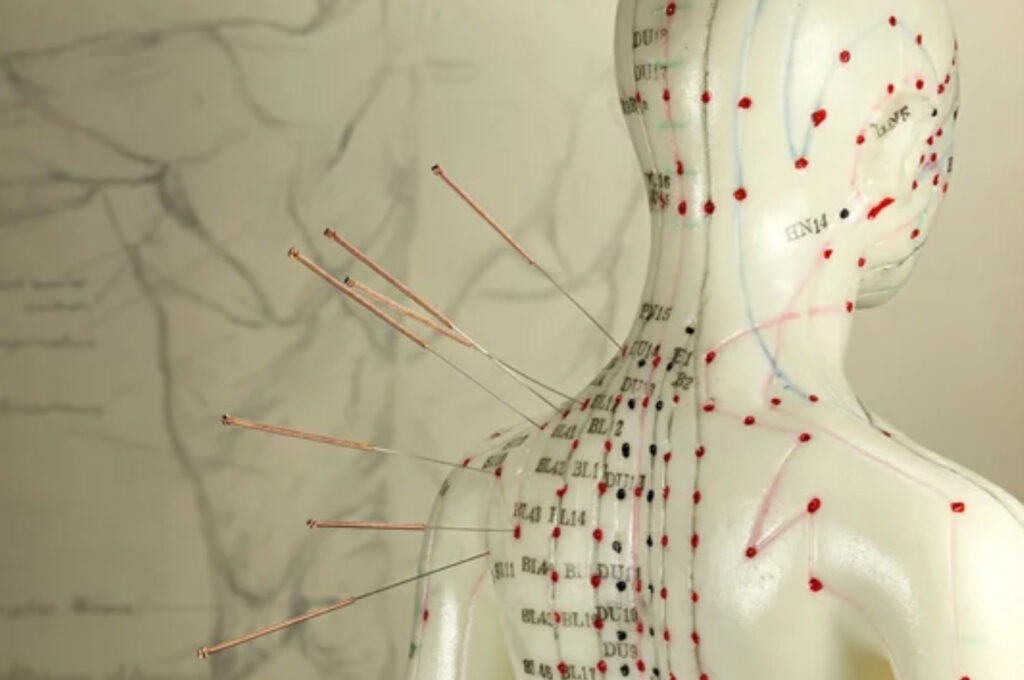 Recent developments in acupuncture include advancements in research, clinical applications, and integration into mainstream healthcare.
Recent developments in acupuncture include advancements in research, clinical applications, and integration into mainstream healthcare.
Here are some of the latest updates:
Research on Acupuncture Analgesia
Studies continue to explore the effectiveness of acupuncture for pain management, with a focus on chronic pain conditions such as lower back pain, neck pain, and osteoarthritis. Research highlights the potential of acupuncture as a non-pharmacological approach to pain relief, emphasizing its safety and cost-effectiveness.
Individualized Acupuncture for Chronic Pain
Recent trials have shown that individualized acupuncture can provide long-term relief for chronic neck pain, offering a promising treatment option for persistent pain conditions.
Latest Advancements in Acupuncture for Chronic Pain
-
- Evidence of Effectiveness
Acupuncture has been shown to be effective for treating chronic pain conditions such as lower back pain, neck pain, osteoarthritis, and headaches. Meta-analyses have demonstrated that acupuncture provides significant pain relief that persists over time, with benefits not fully explained by placebo effects. - Mechanisms of Action
Research has elucidated several mechanisms by which acupuncture relieves pain, including the activation of transient receptor potential channels, suppression of microglial activity, and modulation of cytokines and inflammatory factors Additionally, acupuncture modulates brain networks involved in pain processing, affecting both sensory and cognitive aspects of pain perception. - Integration into Pain Management
Acupuncture is increasingly recognized as a valuable adjunct or alternative to opioids for chronic pain management. Its integration into pain medicine practices and training programs continues to grow, reflecting its safety and cost-effectiveness. - Technological and Methodological Advances
Techniques such as electroacupuncture have been explored for enhanced pain relief compared to manual stimulation. The selection of acupoints and stimulation methods can influence treatment outcomes, with personalized approaches often used to tailor treatments to individual patients.
- Evidence of Effectiveness
Acupuncture in Cancer Care
Acupuncture is being studied for its role in managing chemotherapy-induced peripheral neuropathy (CIPN) and cancer-related pain. Preliminary evidence suggests it may be effective in reducing severe CIPN and improving quality of life for cancer survivors.
Latest Advancements in Acupuncture for Cancer
- Chemotherapy-Induced Peripheral Neuropathy (CIPN)
Acupuncture has shown promise in managing CIPN, a common side effect of chemotherapy. Studies have demonstrated that acupuncture can significantly reduce neuropathic symptoms and improve quality of life for cancer survivors. Ongoing research includes phase 3 trials to further assess its efficacy. - Cancer Pain Management
Acupuncture is being explored for its role in relieving cancer-related pain. Research at institutions like Memorial Sloan Kettering Cancer Center indicates that acupuncture can help alleviate pain, one of the most feared symptoms for cancer patients. - Prevention of CIPN
Recent studies suggest that acupuncture may prevent CIPN when administered concurrently with chemotherapy. A clinical trial found that acupuncture protected against CIPN in patients with colorectal cancer, with benefits lasting at least six months post-treatment. - Integration into Cancer Care
Acupuncture is increasingly recognized as a safe and effective complementary therapy in cancer care. It is used to manage various symptoms, including pain, anxiety, and fatigue, improving overall quality of life for cancer patients. - Future Research Directions
Future studies will likely focus on optimizing acupuncture protocols, exploring its mechanisms, and integrating it more fully into mainstream cancer treatment plans. The use of advanced techniques like electroacupuncture is also being investigated for enhanced benefits.
Emergency Department Applications
A clinical trial at Duke University demonstrated the feasibility and effectiveness of using acupuncture in emergency departments to treat acute musculoskeletal pain, showing an additive effect when combined with conventional pain management.
Here’s a detailed explanation of the trial and its findings:
Overview of the Trial
- Objective: The trial aimed to assess the feasibility and effectiveness of using acupuncture in emergency departments to treat acute musculoskeletal pain. It evaluated whether acupuncture could provide additional pain relief when used alongside conventional treatments.
- Design: The study was a randomized controlled trial involving 236 patients. Participants were divided into three groups:
- Battlefield Acupuncture: This involves stimulating five specific points on each ear.
- Peripheral Acupuncture: This involves stimulating various points on the arms, legs, head, and neck.
- Usual Care Alone: Patients received standard emergency department pain management without acupuncture.
- Procedure: Acupuncture sessions lasted 20-30 minutes and were performed by licensed acupuncturists in the emergency department. The treatments were administered in addition to usual care, which included medications for pain relief.
- Findings: The study found that both types of acupuncture provided significant pain relief compared to usual care alone. There was no significant difference in pain reduction between the two acupuncture methods, so both were continued throughout the study. The results showed an additive effect of acupuncture on pain relief, meaning that patients who received acupuncture experienced more pain reduction than those who did not.
- Implications: The trial highlights the potential of acupuncture as a complementary therapy in emergency settings, particularly for managing acute musculoskeletal pain. It suggests that incorporating acupuncture into emergency department protocols could enhance pain management strategies, potentially reducing reliance on opioids and improving patient outcomes.
- Future Directions: The study’s findings support further research into the use of acupuncture in emergency medicine, particularly for addressing health disparities in pain management. It emphasizes the need for more trials to confirm these results and explore the long-term benefits of acupuncture in acute pain settings.
Scientific Understanding of Acupuncture Mechanisms
Recent research has shed light on the physiological mechanisms behind acupuncture, including the disruption of C fibers and the modulation of brain networks involved in pain processing.
How acupuncture affects C fibers and modulates brain networks:
Disruption of C Fibers
- Role of C Fibers in Acupuncture
C fibers are a type of nociceptor that plays a crucial role in transmitting pain signals. Studies have shown that C fibers are activated by acupuncture, contributing to its analgesic effects. The activation of C fibers can lead to the release of neurotransmitters and hormones that help reduce pain perception. - Mechanism of Action
The activation of C fibers by acupuncture can trigger a cascade of physiological responses. This includes the release of endorphins and other natural pain-relievers, which help to modulate pain perception at both peripheral and central levels. - Importance of C Fiber Activation
Research indicates that blocking C fibers can diminish the therapeutic effects of acupuncture, highlighting their central role in mediating acupuncture-induced analgesia. This suggests that C fibers are key to understanding how acupuncture works to relieve pain.
Modulation of Brain Networks
- Brain Regions Involved
Acupuncture modulates brain networks involved in pain processing, including regions such as the anterior cingulate cortex (ACC), insula, and somatosensory cortex. These areas are responsible for processing pain, emotion, and sensory information. - Neuroimaging Studies
Functional magnetic resonance imaging (fMRI) studies have shown that acupuncture can alter brain activity patterns, leading to deactivation of pain-related areas and activation of regions involved in pain modulation. This modulation helps in reducing pain perception and improving pain tolerance. - Impact on Pain Processing
By influencing these brain networks, acupuncture can effectively reduce pain intensity and improve quality of life for individuals suffering from chronic pain conditions. The modulation of brain activity also supports the role of acupuncture in managing other symptoms associated with pain, such as anxiety and stress.
In summary, recent research has elucidated the role of C fibers in acupuncture’s analgesic effects and highlighted the complex modulation of brain networks involved in pain processing. These findings provide a scientific basis for understanding how acupuncture works and support its use as a complementary therapy for pain management.
Integration into Contemporary Medical Practice
Acupuncture has been increasingly integrated into contemporary medical practice due to its potential benefits in pain management, inflammation reduction, and overall well-being. Here’s an exploration of its mechanisms and integration:
- Cross-Disciplinary Integration
The integration of acupuncture with modern medicine is becoming more prominent, particularly in fields like neurosciences, anesthesiology, oncology, and psychiatry. This integration involves using modern medical methods to study acupuncture’s mechanisms and enhance its applications. - Pain Management
Acupuncture is increasingly recognized as a complementary therapy for pain management, offering a non-pharmacological approach that can reduce reliance on opioids. Its integration into pain clinics and emergency departments is being explored for managing acute and chronic pain. - Global Acceptance
While acupuncture is widely used globally, its acceptance in Western medicine is growing. Centers like the Southern California Oriental Medical Center are leading the way in integrating traditional Chinese medicine with Western practices. - Future Directions
To further establish acupuncture’s role in modern medicine, more scientific research is needed. This includes conducting rigorous clinical trials and using advanced technologies to understand its mechanisms and optimize its applications.
Acupuncture’s integration into contemporary medical practice is supported by its potential mechanisms, including the stimulation of afferent fibers, neurotransmitter release, and anti-inflammatory effects. As research continues to elucidate these mechanisms, acupuncture is becoming more accepted as a complementary therapy in various medical disciplines.
These developments highlight the growing interest in acupuncture as a complementary therapy for various health conditions, with ongoing research aimed at understanding its mechanisms and expanding its applications in healthcare.
To learn more about how acupuncture can help you, contact us today!…
Contact Urban Acupuncture Center in Columbus, OH For More Information
For more information about how acupuncture, massage therapy, electroacupuncture and other alternative healing treatments can help you, please contact the Urban Acupuncture Center Board Certified Licensed Acupuncturist’s team at Indianola Ave, Columbus, Ohio (Clintonville) (614) 725-2488 or click here. Taking new patients in and around greater Columbus, Ohio.
